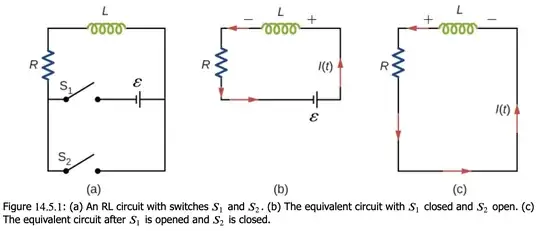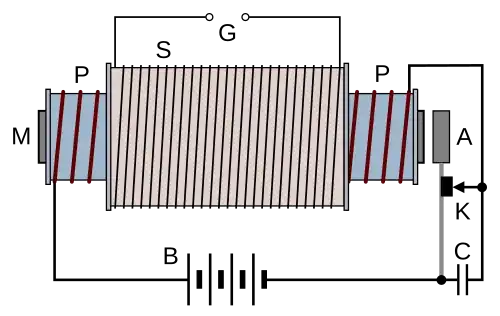Consider the RL circuit in (a). Figures (b) and (c) represent what happens when one of the two switches is open while the other one is closed (this is discussed in this link). 
In figure (b), where $S_1$ is closed, the circuit basically consists of a resistor, an inductor and a cell. In figure (c), where $S_1$ is opened and $S_2$ is closed, it reduces to a resistor and an inductor only.
When both $S_1$ and $S_2$ are open, no current flows in the circuit. Suppose that in $t=0$ the switch $S_1$ is closed. Applying Kirchhoff's second law, it can be seen that the current $i(t)$ is described by the following function, which is the solution of a non-homogeneous first-order ODE: $$i(t)=\frac{\epsilon}R\left(1-e^{-\frac RL t}\right)=\frac{\epsilon}R\left(1-e^{-\frac t \tau}\right).$$
After enough time, the current is very close to $\frac{\epsilon}R $. Then, letting $t=0$ be the time when $S_1$ gets opened and $S_2$ closed, with $i(0)=\frac{\epsilon}R$, one finds that $$i(t)=\frac{\epsilon}Re^{-\frac t \tau}.$$
This is precisely what we would expect: if the cell is "bypassed", then the current will eventually vanish, while the energy will be dissipated in the resistor and stored in the inductor.
What would happen, however, if instead of "bypassing" the cell with the bottom part of the circuit, I only opened $S_1$ after the current gets close to $\frac{\epsilon}R$? I could not apply Kirchhoff's loop rule (as my open circuit would not be a loop anymore). When approaching the switches, the current would be "stuck". I guess that it would not stop flowing immediately, but I don't get where it could go. How can I determine an equation describing the current in this case?
